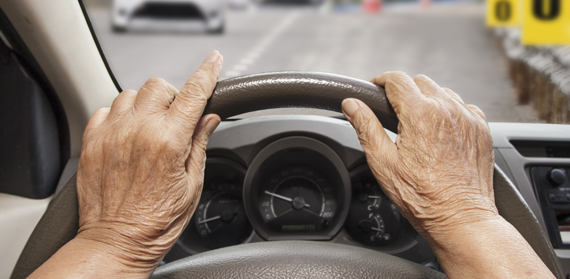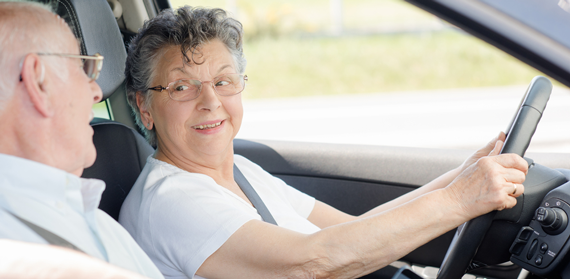Guest post by Professor Andrew Parkes, Head of the Centre for Mobility & Transport
GPs must tell the DVLA about any patients who continue to drive when they are viewed as medically unfit to do so, says the General Medical Council.
The regulator is strengthening its advice after hearing from GPs who feel anxious about reporting patients to the driver licensing agency. The draft guidance, which is currently out for public consultation, says public safety should come before patient confidentiality and consent in such cases.
The GMC says Confidentiality is not absolute and doctors can play an important part in keeping the wider public safe if a patient is not safe to drive
The guidance also emphasises that when doctors diagnose a patient’s condition, or provide treatment, they should keep the patient’s ability to drive safely at the forefront of their minds.
This statement highlights the problem of judging just when to give up driving. Too late and the consequences could be catastrophic and tragic; too early and there could be severe consequences for the quality of life of the patient.
Older drivers in the UK have been generally considered safer than young drivers when collision statistics are examined in detail. In fact, accident involvement is at its lowest rate for drivers aged 70-79, and remarkably only increases by 20% for drivers aged 80 and over.
However we should note that though current older drivers may be safer on the roads, in terms of collision involvement per trip, increased frailty means that they are more likely to die or be seriously injured in any given accident than their younger counterparts. According to data from the Department for Transport, drivers aged 60-69 had an average of 18.8 casualties per billion miles driven. This number increases to 56.7 casualties for drivers 70 and older. We need to improve safety for older drivers and the solutions required may be different to those for other segments of the driving population.
The population of the UK is aging rapidly; 15% were 65 years or older in 1984 and this is projected to rise to 23% in 2034. It is those aged 85 and over, the “oldest old”, where the increases are the greatest. Compared to 1984, when approximately 660,000 people in the UK fell into this category, the number had increased to 1.4 million in 2009 and is projected to reach 3.5 million in 2034.
So, we will have more older people in the coming years and we know that if they drive they are likely to have a particular type of accident and injury profile, but what do we really know about the numbers, the requirements and limitations of older drivers in the future?
In 2009, 54% of people aged 70 years or older held a current driving licence compared to 27% in 1985/86 (National Travel Survey, 2009). Currently existing gender differences in licensure rates and car use are evening out: the proportion of women aged 70 years and older holding a car driving licence increased from 11% in 1985-86 to 37% in 2009. The proportion of men with a licence rose from 51% to 76% over the same period. In the 60-69 age group, licensure rates in 2009 were 90% for men and 67% for women respectively, suggesting that prevailing differences in licensure rates will disappear as younger people, most of whom will have driven throughout their adult lives move into retirement age.
Because older drivers have not been seen as a problem population, in the same way that young novice drivers are, there has been a tendency to overlook their particular problems and to assume that once drivers start to feel driving becoming difficult they will be inclined to avoid challenging situations (heavy traffic, night driving and so on) and eventually remove themselves from the driving population entirely. Hence, although we all may have anecdotal stories of aged relatives and their nightmare driving, the picture for the foreseeable future, at a societal level, has been that they have relatively few accidents and tend to self-regulate themselves out of the driving population at the appropriate time. The raw statistics hide important and interesting detail. Research has shown, for example, that older drivers tend to make shorter journeys and be overrepresented in intersection or right-of-way crashes. This has been interpreted as due to problems with reaction times, hazard perception, or to allocation of attention, or may be simply due to reduced neck flexibility and mobility.
A prevailing view has been that though older drivers have rather different problems to the rest of the driving population, they are not over represented in accident statistics, will give up driving when they start to feel it is too difficult and will benefit alongside everyone else with general improvements to vehicle safety and highway design.
With this view, it can be argued that transport research priorities should be focused elsewhere.
I hold different views that can be summarised as follows:
- In future there will be far more older drivers, driving more often and in a much wider range of traffic conditions
- It is a mistake to think that the future older driver population will have the same characteristics as today – age and gender profiles will change, as will health issues, social networks, economic capabilities and mobility expectations
- Driving will be increasingly important to quality of life and social inclusion for the older population – even at reduced mileage levels people will wish to keep driving licences into their 80’s, 90’s and even 100’s far more than today
- New technologies open up huge potential for supporting older drivers – both in the control of the vehicle and also in information and tailored services that can prolong and enhance their mobility and social inclusion
- The UK can be at the forefront of thinking about innovation for the older driving population – this includes new vehicle types and assistance systems, new hazard perception and skills training, new insurance purchasing and leasing models, new systems to help drivers self calibrate their performance, new research in physiology, neuroscience and socio-economics.
The current picture is changing, quite quickly, and we need to think ahead, now. The older drivers deserve to have their safety requirements at the forefront of the UK research and policy agenda. There is also considerable opportunity for UK science and industry to exploit innovative thinking and system development in transport markets worldwide.
Examples of recent contributions in this area include:
Report for RAC Foundation on the role of self-assessment tools for older drivers
Report for Road Safety Observatory highlighting key facts on older drivers
http://www.roadsafetyobservatory.com/KeyFacts/drivers/older
Input to on-line resources to help families address the issues surrounding driving cessation and quality of life





Comments are disabled